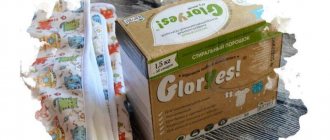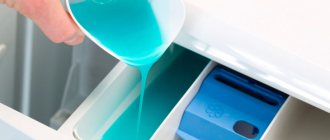Sometimes it happens that a purchased item or material was initially soft to the touch, but after washing it becomes rough, prickly, hard and completely unwearable. Every person wants to feel comfortable in clothes, especially if they have to be in them all day. Your favorite blouse, jacket, dress, trousers are put on the far shelf, but they were in such harmony with other things.
Why does this happen? Sometimes washing conditions are not met. By setting a higher temperature on the washing machine programmer, you can unwittingly ruin the quality of the fabric. Often the situation can be corrected. You will have to try some techniques so that the clothes become pleasant to the body again and do not cause negative feelings.
The first thing we can suggest is to use washing powder, liquid SMS and conditioner intended for this type of fabric, follow the heat treatment and washing regimes. That is, read the label and follow the recommendations.
But there are methods that housewives use successfully. In this article we will reveal the secrets of softening all types of fabrics.
Cotton
The high rigidity of cotton fabric is due to the processing of threads using special glue. To soften the material, you need to wash the item of clothing several times with regular powder, and use conditioner when rinsing. After 2-3 such procedures, the textiles become softer.
Note : Cotton clothing should not be washed at temperatures above +60 degrees, as this may cause the product to shrink.
Methods for softening different types of fabric
Each fabric has its own composition, weave and density, so for each type there is a more preferable softening method. For example:
- Cotton - the glue used to process the fibers can give it uncomfortable rigidity. To soften it, you need to wash the item several times before use, and be sure to add conditioner when rinsing.
- Denim - soda solution will make it soft. 3-4 tablespoons per glass of water, pour it into the machine and wash at 40 degrees. Be sure to add conditioner when rinsing.
- Linen - soak things in a saline solution (5-7 spoons per 5 liters of water) and leave overnight. Wash in the morning.
Instead of salt and soda, you can use a solution with a double dose of conditioner. Products should be left in it for a day and then simply rinsed. It is also worth highlighting a few tips that will protect you from mistakes when softening fabric:
- when using vinegar, use only white vinegar, do not use colored or apple vinegar, as they can change the color of the product and leave stains on it;
- Never mix white vinegar with chlorine bleach, as the reaction will produce a dangerous gas;
- do not use baking soda on dark fabrics, it can lighten them;
- Wash items at a temperature no higher than 60 degrees to avoid shrinkage and rapid wear.
Using these tips, your fabrics will always be soft, and your clothes will always be soft and comfortable.
Denim
An alkaline solution will make jeans soft. To prepare the product, you need to dilute 3-4 tablespoons in one glass of water. The resulting liquid should be poured into the washing machine compartment and washed at a water temperature of +40 degrees. Jeans should be rinsed using fabric softener.
Note : this method is not suitable for processing dark clothes, since such clothes may lighten under the influence of soda.
To soften linen fabrics, it is necessary to soak the items in 5-7 liters of water diluted with 3-5 tablespoons of table salt. Leave the clothes in a container of water overnight and wash them in the morning.
Dilute two doses of conditioner in a basin of warm water and immerse things there for a day. After 24 hours, clothes should be rinsed or washed with conditioner.
Pour acetic acid into a basin of water to a two percent solution and soak the clothes in the reservoir for several hours. Next, rinse the item well several times. If after a set of procedures a sour smell remains, you can wash it.
More information about clothing care can be found from the manufacturer Vulkana.
Synthetic fabric is widely used in everyday life. While inferior to natural fabrics in hygiene, it surpasses them in wear resistance, affordability, and ease of care. In terms of aesthetic properties (color range, quality of fibers) it is equivalent to silk, wool, cotton. But, to preserve these qualities for a long time, you need to know how to wash polyester correctly.
What to do if the bed linen is hard?
during washing, you can add another rinse, in a special compartment for powder, add 1 tablespoon of table salt per liter of water, this will help soften the laundry and reduce water hardness; If you use the drying mode, it is better to choose a temperature much lower than when washing.
Interesting materials:
What is needed to obtain a Schengen visa to Spain? What is needed to obtain a tourist visa? What is needed to obtain a Schengen visa? What is needed to obtain a visa to the Czech Republic? What do you need to apply for a visa to Finland? What is needed to obtain a visa to Greece? What is needed to obtain a visa to Spain? What is needed to obtain a visa to Poland? What do you need to apply for a visa to France? What is needed to obtain a voivodeship visa?
Features of the material
Polyester is a synthetic fabric made from polystyrene. Polystyrene is a product of petroleum refining. Fiber is obtained from the liquid fraction after purification and processing. In the textile industry, it is used to make fabric used for sewing clothes and equipment. According to the characteristics of 100% polyester, it is close to cotton fabric, and in appearance it resembles pure wool.
- wear-resistant;
- does not fade from the sun;
- moisture resistant, dries quickly;
- does not wrinkle when cutting and sewing;
- pleasant to the skin;
- does not absorb odors.
Disadvantages of synthetic products:
- low hygroscopicity;
- high density (rubbed upon contact with skin);
- become electrified;
- attract dust;
- flammable;
- lose their shape at temperatures above 40 degrees.
To improve the quality of the fabric (firmness, elasticity, density), cotton, wool, viscose, and elastane are added to polyester.
The following are sewn from polyester materials:
- thermal underwear;
- sports;
- outerwear;
- home textiles (tablecloths, curtains, bed linen, carpets);
- equipment (backpacks, tents);
- the wrong side of suits, dresses, jackets, coats.
Synthetic fibers are used as filler in down jackets and jackets (holofiber).
What kind of fabric is cotton and polyester?
Polycotton is a fabric formed by a combination of polyester and cotton. ... Indeed, there is a fabric made from a combination of polyester and cotton, which is called polycotton. This is a mixed fabric.
Interesting materials:
How to preserve a bouquet of flowers longer? How to save tulips until spring? How to save Far Cry 5? How to save photos from OneDrive? How to preserve dahlias before planting? How to save milk mushrooms until tomorrow? How to save an html page in notepad? How to save HTML in Notepad++? How to keep apples fresh for the winter? How to store apples in the cellar until spring?
How to properly wash things in an automatic washing machine
The water temperature must correspond to that specified by the manufacturer: 30, 40, 60 degrees. It depends on the composition of the fabric. Mixed materials are more resistant to elevated temperatures. You cannot wash it in water temperatures below 20 degrees: the powder will not dissolve. The detergent can be powder or liquid, depending on the type of item being washed.
Washing mode – delicate. Time – 30 minutes. Adding conditioner will make the product softer. Pure polyester can be washed without spinning. The item is laid out or hung, allowing the water to drain. Combined fabrics are wrung out at minimum speed.
How to remove stains from polyester fabric
Polyester is generally stain resistant, but anything can happen. The main rule in this case is that any product that you use to remove stains, initially test it on an inconspicuous area, for example, on the wrong side, and only then proceed to remove:
- Treat the affected area with a stain remover or mild detergent.
- Place the product on a flat surface and lightly wipe the stain with a soft cloth. Rubbing with hands, brushes, or a hard sponge is prohibited.
- Wait 5-7 minutes and wash the item in a way convenient for you, according to the washing rules.
If the stain remover does not help, you can try treating the material with a folk remedy - moisten it and apply regular salt. Wait 30 minutes, wash off any remaining salt with soapy water and rinse the product thoroughly.
General tips and tricks
Polyester items quickly become dirty due to their ability to attract dust. This is especially true for outerwear, sports and travel equipment. Regular cleaning of products is required. If we generalize the conditions for washing polyester products, they can be divided into 2 groups: how to wash and with what.
By washing
For hand and machine washing, the water temperature should be in the range of 30-40 degrees. Higher heating must be permitted by the manufacturer. Products made from thin polyester are washed in fabric covers.
The washing mode in the machine is automatic – delicate. Spin is allowed at minimum speed. Wash by hand without using brushes, without twisting during spinning.
By choice of product
Wash in cold water without powder, using conditioner and laundry soap. Liquid detergent or powder is dissolved in warm water. Do not use products containing chlorine. The addition of conditioner during rinsing gives clothes antistatic properties.
Machine wash polyester
To understand how to wash, you need to understand the basic rules for caring for such things. They include several important points, knowing which you can constantly maintain the quality of the fabric at the proper level:
- Before loading, all items should be carefully sorted by type of material and color. It would be better to pre-pack the most delicate items of clothing in a special washing case;
- Stains on the fabric must be removed with your own hands before the items are placed in the car.
If the dirt is shallow, a possible option is to use the pre-wash or soak mode;
- To care for colored items, you must select a separate detergent. When choosing, you need to be guided by the mark “for color” / “Color”, which should be contained on the label. As noted earlier, the selected powder (gel, shampoo, etc.) must be soft enough to allow washing in a gentle mode without damaging the fabric;
- When programming the number of revolutions, you should not exceed the value of 800 - it is optimal for polyester. At the same time, if the washing machine chamber is loaded to the limit, it would be useful to use the additional rinse function;
- The required washing mode is delicate or manual. If the machine provides the ability to clean sports items in a separate mode, it is worth using;
- To maintain the volume of clothes made of polyester fabric, and at the same time give it softness, it is better to additionally use conditioner. After washing, you will need a dryer for faster drying; you can also wipe the items with a terry towel.
Subtleties of washing some products
The particularity of washing depends on the density of the fiber weave, additional components to polyester, and the type of product.
Coat
The fabric on the coat is thick. Coats are washed in an automatic machine. Washing temperature – 30 degrees. Processing mode – “delicate”/“synthetic”. An additional rinse is used to completely remove the detergent (washing powder).
Dry flat, on hangers. When wet, iron with a warm iron to smooth out the front and back. When dry, iron through moistened gauze. Mixed fabrics (with wool, viscose) are rolled up after washing. It is recommended to dry clean such items.
Jacket
A polyester jacket is washed inside out. Before this, unfasten the hood, empty the pockets and fasten all the buttons and zippers. Water heating - 30 degrees. Drum operation in “delicate” mode. Spin – up to 400 rpm. Additional rinse. As a detergent - washing powder.
After the automatic machine, the jacket is hung on hangers without turning it inside out. When the inside is dry, dry the top. If the thermal insulation filler is polyester fibers (holofiber), then washing depends on the type of fabric at the top of the jacket:
- The insulated lining is detachable from the jacket. Holofiber is elastic, coiled threads that do not absorb moisture and have good thermal insulation properties. The material is resistant to temperatures up to 90 degrees and chlorine-containing stain removers. Wash the liner as usual, with a spin cycle. Synthetic insulation does not wrinkle and dries quickly. The detergent must have a liquid consistency so that it is completely removed when rinsing. The powdered product is not washed out, retaining the smell of washing powder. The washed item is hung on a rope or hanger. Dries in a few hours.
- The lining with holofiber cannot be detached; the top of the jacket is made of raincoat fabric. The washing mode corresponds to the coating of the product. Water temperature is 45-50 degrees. Using liquid detergent. Spin. The raincoat fabric is resistant to mechanical stress, including the use of brushes during hand washing. Chlorine stain remover will discolor the fabric. Thick fabric is dried in a draft.
- The jacket is covered with membrane fabric. Washing requires careful handling in manual and automatic modes. With the manual method, the water temperature is no higher than 35 degrees. The jacket is soaked in water, gel or shampoo for membrane fabrics is added. Wipe the top with a soft sponge. Rinse. Allow the water to drain and hang it on hangers. After half an hour, dry using terry cloth. Dry completely flat on a hygroscopic fabric. In the machine, the machine is set to a “delicate” mode, without spinning and drying, the temperature is 40 degrees, a liquid product is added. Dry the product as if washed by hand.
- Polyester covering. Machine and hand wash at a temperature not exceeding 40 degrees, with liquid detergent. Manual spinning, without twisting. Set the machine to minimum speed and turn off the drying mode. The jacket is dried on hangers, avoiding direct sunlight and proximity to heating devices.
- Bologna top. Items are washed by hand, without using brushes or twisting. The detergent is liquid. Water temperature - 40 degrees. The machine can be washed in a protective cover. Drying in the shade.
Care of the jacket must be carried out in accordance with the markings on the label. The quality of holofiber is checked using a certificate.
Down jacket
Winter clothes can have a synthetic top, filling, and lining. The combination of down jacket elements depends on the manufacturer and model.
A down jacket with natural filling (down, down-feather, feather), coated and lined with polyester, can be washed by hand or in an automatic machine. Care details are indicated in the manufacturer's instructions. Typical washing requirements for items with down and feathers and a polyester top:
- water temperature – 30-40 degrees;
- delicate mode;
- the use of special shampoos and gels.
- using tennis balls when loading into the washing machine (to maintain the shape of the product);
- no spin;
- bleach;
- Drying on a net, flattened.
Such prickly wool
Do you like to wear things that keep you warm without getting cold from gusts of wind? Products made from wool fabric have these properties. But how unpleasant it is to feel the skin tingling with villi. What to do? Be sure to wash such items with liquid detergents that are intended only for this type of fabric. Be sure to use conditioner - it will eliminate the hardness of the lint.
Previously, housewives used for these purposes:
- solution of table salt and vinegar;
- dry mustard wrapped in a linen bag;
- citric acid;
- glycerol.
Pour water into a basin, add one of the suggested remedies (2-3 tablespoons) and leave for 15 minutes. After this, rinse in cold water.
Also in this case, it is ideal to sew a lining to the product.
When buying fabric for any products, we often pay attention to its color and texture, determine the composition (natural or synthetic), and also select an acceptable price. And only when we start working with her do we realize that she is quite tough. The same thing happens with clothes that, after five minutes of trying on, seemed ideal to us, but when worn for a long time, they rub and cause irritation of the skin due to the hardness of the material.
But don't get upset or throw things away. This problem can be easily fixed.
Today you can find many fabric softeners on sale that are used after washing during rinsing. They make products soft, tender and fresh. But at the same time, they contain many chemicals, including fragrances, which remain on things and then come into contact with the skin. This can cause allergies and various health problems in some people.
There is an alternative to such chemicals in the form of natural substances that will cope with the task no worse, and will also be much cheaper:
- Vinegar. This product can be found in every kitchen. It's cheap and non-toxic. It is acidic, unlike detergents and powders which are alkaline, so it softens products by neutralizing soap residue. In addition, it will get rid of static, and thanks to its antimicrobial properties, it will also disinfect things. Just add 1/4 cup of vinegar to the rinse water, and your softening conditioner is ready. If you don't like the smell, you can add a couple of drops of essential oil.
- Soda. Regular baking soda, which you use for baking, works great for softening water and also making things softer. In addition, it also helps deodorize clothes, normalizes pH levels, eliminating excess alkalinity and acidity. Add a quarter cup of baking soda to your washing water. You can first dissolve it in water and add the solution to the machine.
- Salt. Dissolve half a glass of table salt in the soaking water and leave for several hours. You can use coarse sea salt.
- Borax. Just like baking soda softens water. In addition, it is an excellent cleaner that simultaneously destroys mold and mildew, dust mites, and also removes odors from things. But this remedy cannot be abused, as it is quite aggressive. To soften the water when washing, it is enough to use half a glass of borax during normal loading of the machine. Using it as a conditioner, you need to add a quarter cup to the rinse water.
- Combination of substances. A combination of baking soda and vinegar can be an effective fabric softener. Just pour in the vinegar very carefully, as a violent neutralization reaction will occur. The salt obtained as a result of the reaction will be the softening element. Mixing coarse salt with baking soda in a 2/1 ratio will also give a good softening effect when rinsing. And when you add essential oil to a dry mixture, you will get a unique fragrance.
There is another version of the original rinse composition that will make the fabric soft. Add any hair conditioner and vinegar in a 3/2 ratio to hot water. This composition will not be completely natural, but the effect will be amazing.
How to dry properly
Polyester items should not be dried in the sun or near heating appliances. They will warp from ultraviolet and infrared radiation, losing their shape. Products made of thin fabric, with natural and artificial additives require placement on a horizontal surface (mesh or well-absorbent moisture). Dense synthetic fabric does not lose its shape when drying clothes on hangers.
How to make linen fabric softer?
Soaking in salt or soda It is necessary to prepare a solution at the rate of 1 glass of salt or soda per 5 liters of water and soak the linen item in it overnight. Then you should thoroughly wash the product at a temperature of 60°C at maximum speed and iron it.
Interesting materials:
What is the name of strawberry fruit? What is the thick fabric for curtains called? What is the scientific name of geranium? What are wood defects called? What is the name of memory foam? What is the name of the bed linen reaper? What is the name of the device for measuring atmospheric pressure and how does it work? What is the name of the device for measuring wind direction? What is the name of the device for measuring outdoor air temperature? What is the name of the device for indicating wind direction?
Rules of care
Fulfilling the manufacturer's requirements makes it possible to preserve the shape and color of products for a long time. When buying a synthetic item, you must first of all pay attention to information about the rules of care. Get acquainted with the quality certificate from the distributor.
Conditions that will make caring for polyester easier:
- To reduce the electrification that attracts dust, use conditioner when washing.
- Daily cleaning of outer clothing (coats, jackets, down jackets) from dust will slow down contamination and the need to use detergents. Just shake it off and brush it off with a soft brush.
- Blended fabrics require adjustments to storage, washing and drying rules.
- Gentle wash:
- low temperature;
- at low speeds (machine);
- without friction (with hands);
- with shampoos, gels, conditioners;
- without spin/with delicate spin.
- Careful drying.
- Ironing in exceptional cases.
The listed rules are general in nature. A specific product requires an individual approach. It depends on the thickness of the threads, the type of weaving, additives in the polyester composition, and the combination of other materials in the product.
Sometimes it happens that a purchased item or material was initially soft to the touch, but after washing it becomes rough, prickly, hard and completely unwearable. Every person wants to feel comfortable in clothes, especially if they have to be in them all day. Your favorite blouse, jacket, dress, trousers are put on the far shelf, but they were in such harmony with other things.
What not to do
Before you start washing any clothes, you need to find out the composition of the fabric. This information can be read on the label. If it is lost, do a little experiment. Pull the thread from the clothing and light it with a match. If the thread melts, it means it contains synthetics. The presence of polyester fibers in the fabric indicates that the following is prohibited:
- Boiling procedure. Prolonged exposure to high temperatures will cause clothing to deform.
- Washing and soaking in water above 40 C°.
- Whitening clothes. Bleach is not suitable for artificial fabrics. After their use, clothing becomes unfit for wear.
- Dry in the sun and radiator. Ultraviolet rays and heating devices destroy polyester fibers.
There are no special care requirements for polyester. But in order to maintain the original appearance of the product, you need to adhere to several rules.
Note: how to wash a jacket with padding polyester
What makes denim and cotton coarse?
First of all, this comes from the water in which you wash the item. A trivial situation - the content of salts and chalk leads to the fact that natural fabric becomes very hard. The housewife can puzzle over this issue for a long time, changing the washing powder, but not achieving the desired effect. If your system has a centralized water supply, the cause may be salt deposits in the pipes. Well water may contain excess chalk. The solution to the problem is very simple - you need to install a cleaning and softening filter at the inlet of the washing machine, and the problem will disappear by itself.
Washing denim and cotton fabrics in water that is too hot will cause shrinkage as the fibers become compressed. Therefore, they should be washed at a temperature of no more than 50 °C. But if this unpleasant situation occurs, soak the item in cool water, wait for 15 minutes, dry, and then steam without touching the sole of the iron to the surface of the fabric. For this purpose it is better to use a steam generator.
Women have long learned to soften fabrics made from cotton fibers (and jeans are woven from them) with a soda solution. Add 3 tablespoons of baking soda to an 8-liter bowl of water, leave for 20 minutes and rinse with conditioner. You can twist with effort to soften the fibers. Place the denim items in the washing machine and put in special wash balls, turn on the intensive spin mode. This will help eliminate stiffness.
How to restore the shine of silk?
The fact is that it is better to rinse silk first in slightly warm water, and then in cool water. But we will add a little table vinegar to cool water, this will help revive the color and restore the brightness and shine of the fabric.
Interesting materials:
What collateral always remains with the pledgor? Which printer is suitable for sublimation printing? What product is considered kosher food for Jews? Which tea manufacturer is better? Which flour manufacturer is better? What strait connects the Atlantic Ocean? What strait is in Africa? What percentage does Sberbank charge for utility bills? What processor for GeForce 1070? Which wire is plus black or white?
Even synthetics will become soft
Many synthetic fabrics have properties that can be safely put on the same scale as natural ones. This is about technical characteristics. And if we talk about the possibilities of creating a unique design, then sometimes they have no equal. All girls now sew dresses and skirts from neoprene, they are at the peak of popularity.
Your wardrobe probably contains clothes made from materials that contain unnatural fibers:
One way or another, things made from synthetic fabrics have firmly entered our lives, so it is necessary to know how to handle them in order to ensure comfortable wearing.
To make this material soft, you need to use a conditioner and be sure to follow the rules indicated on the clothing label. Some housewives use vinegar or prepare the mixture themselves. But why resort to such methods if specialized products are sold in stores.
Stretching
Jeans can become stiff if the fabric shrinks a little after washing. Then the material becomes denser and can even rub in intimate places.
To make the fabric softer, it must be stretched.
How to stretch:
- Pour water into a spray bottle. Lightly moisten the material, put it on yourself and walk around until the material dries. Remove the item and iron it.
- You can stretch wet trousers with your hands. Step on the end of the pant leg with your foot and press down well. Grasp the belt with your hands and pull as hard as you can. The fabric will stretch a little and become softer.
- Softening the material in the calf area is difficult, but not impossible. Put on your pants and place your feet in the bath up to your knees. Sit in a warm bath for 15 minutes, periodically stretching the material in the calf area.
Stretch is a good option for softening fabric, but it only lasts until the first wash. After this, the procedure will have to be repeated again.
To make linen clothes pleasant to wear
Linen is a fabric from which people have been sewing clothes since time immemorial. Manufacturing technology involves the use of natural fibers, which are obtained in factories in several stages. Due to this, the fabric is soft. But sometimes you discover that the purchased item is itchy and unpleasant to wear.
Don't despair; the fibers may not have softened during one of the processing steps. You can make it softer at home. To do this, you should boil the thing that is pricking in water with the addition of a soap-soda solution. Please note that this can only be done if you are sure that the fabric is natural - synthetic fibers cannot withstand high temperatures and curl up.
Try steaming the item with a hot iron, after washing and rinsing the item using conditioner. Another effective option is to contact a tailor to have a lining sewn onto your product.
Softening fabric when drying
You can soften the fabric not only during the washing or rinsing process, but also during the drying stage. You need to put dryer balls in the dryer along with your clothes. Such means:
- made of plastic or rubber;
- soften linen purely mechanically, moving between products;
- reduce drying time;
- remove static electricity;
- prevent tissue shrinkage.
You can make such balls with your own hands from ordinary woolen threads. It is enough to wind 4-5 tight balls the size of a tennis ball, and then put them in old tights, tying a knot behind each. Next, they need to be washed in very hot water and dried in the dryer on the hottest machine setting. The balls will become matted and compacted, after which they can be used to dry things.
The advantages of homemade balls are that they:
- do not contain chemical impurities - completely natural;
- have low cost;
- open access to hot air things, separating them;
- make clothes surprisingly soft and fluffy;
- reduce drying time;
- You can drop essential oil into wool balls, which will give things a unique aroma.
There is a method of using tennis balls as balls. Their principle of operation and the resulting effect are the same as those of traditional balls. But, given their material - rubber, which is not intended for high temperatures, if the dryer is too hot, chemicals may be released, after which an odor will remain on the laundry.
One of the simple and accessible folk methods of softening fabric when drying is the use of cotton fabric. It may be old and unnecessary, but it must be clean and natural. It needs to be cut into small squares with a side of approximately 13 cm. You need to sprinkle the pieces with vinegar until completely moistened, and then put them in the dryer. Vinegar will be the element that softens things. You can add a few drops of essential oil to each piece of clothing, this will give your clothes your favorite scent.











